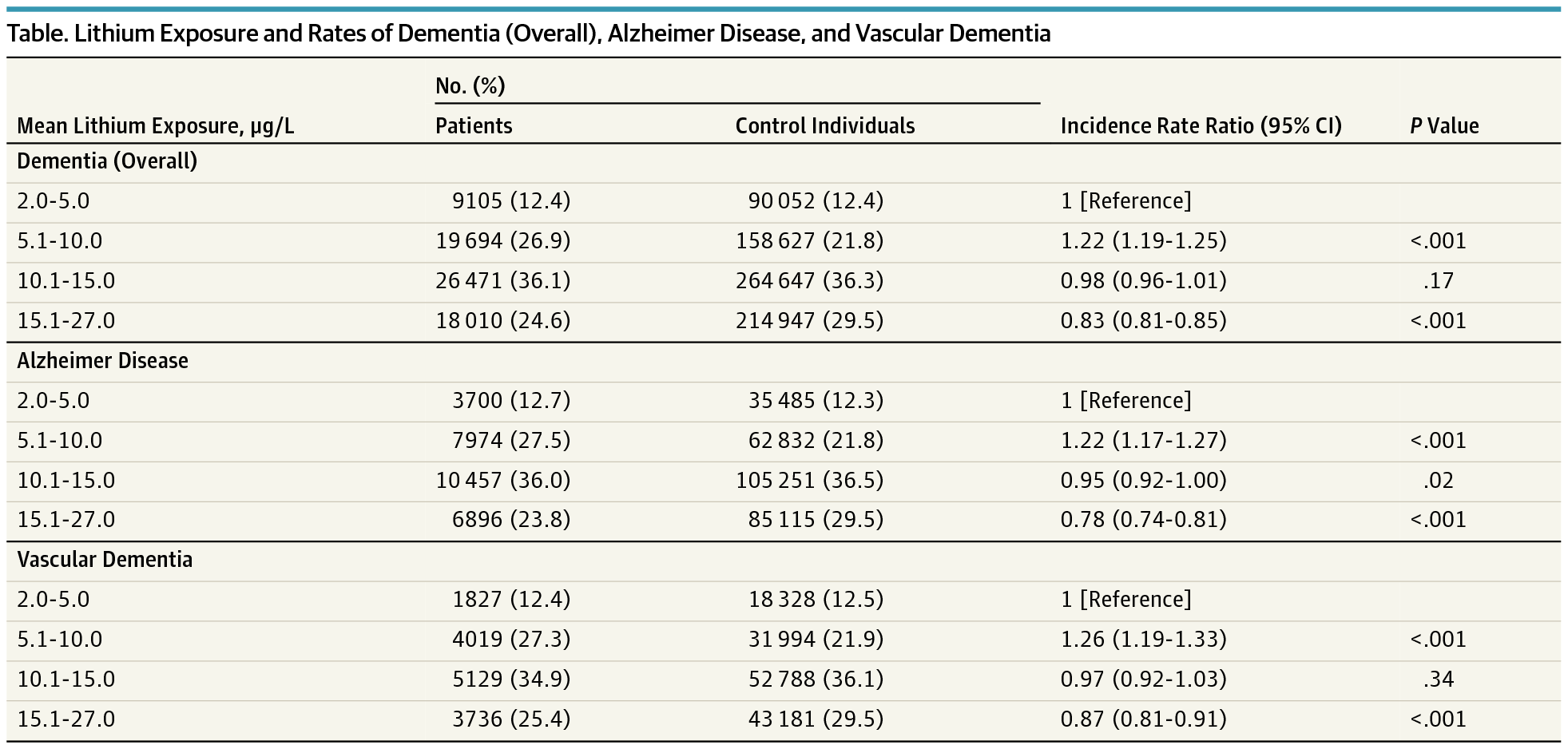JAMA Psychiatry ( IF 22.5 ) Pub Date : 2017-08-23 , DOI: 10.1001/jamapsychiatry.2017.2362 Lars Vedel Kessing 1 , Thomas Alexander Gerds 2 , Nikoline Nygård Knudsen 3 , Lisbeth Flindt Jørgensen 4 , Søren Munch Kristiansen 5 , Denitza Voutchkova 6 , Vibeke Ernstsen 4 , Jörg Schullehner 4 , Birgitte Hansen 4 , Per Kragh Andersen 2 , Annette Kjær Ersbøll 3

|
Importance Results from animal and human studies suggest that lithium in therapeutic doses may improve learning and memory and modify the risk of developing dementia. Additional preliminary studies suggest that subtherapeutic levels, including microlevels of lithium, may influence human cognition.
Objective To investigate whether the incidence of dementia in the general population covaries with long-term exposure to microlevels of lithium in drinking water.
Design, Setting, and Participants This Danish nationwide, population-based, nested case-control study examined longitudinal, individual geographic data on municipality of residence and data from drinking water measurements combined with time-specific data from all patients aged 50 to 90 years with a hospital contact with a diagnosis of dementia from January 1, 1970, through December 31, 2013, and 10 age- and sex-matched control individuals from the Danish population. The mean lithium exposure in drinking water since 1986 was estimated for all study individuals. Data analysis was performed from January 1, 1995, through December 31, 2013.
Main Outcomes and Measures A diagnosis of dementia in a hospital inpatient or outpatient contact. Diagnoses of Alzheimer disease and vascular dementia were secondary outcome measures. In primary analyses, distribution of lithium exposure was compared between patients with dementia and controls.
Results A total of 73 731 patients with dementia and 733 653 controls (median age, 80.3 years; interquartile range, 74.9-84.6 years; 44 760 female [60.7%] and 28 971 male [39.3%]) were included in the study. Lithium exposure was statistically significantly different between patients with a diagnosis of dementia (median, 11.5 µg/L; interquartile range, 6.5-14.9 µg/L) and controls (median, 12.2 µg/L; interquartile range, 7.3-16.0 µg/L; P < .001). A nonlinear association was observed. Compared with individuals exposed to 2.0 to 5.0 µg/L, the incidence rate ratio (IRR) of dementia was decreased in those exposed to more than 15.0 µg/L (IRR, 0.83; 95% CI, 0.81-0.85; P < .001) and 10.1 to 15.0 µg/L (IRR, 0.98; 95% CI, 0.96-1.01; P = .17) and increased with 5.1 to 10.0 µg/L (IRR, 1.22; 95% CI, 1.19-1.25; P < .001). Similar patterns were found with Alzheimer disease and vascular dementia as outcomes.
Conclusions and Relevance Long-term increased lithium exposure in drinking water may be associated with a lower incidence of dementia in a nonlinear way; however, confounding from other factors associated with municipality of residence cannot be excluded.
中文翻译:

饮用水中锂与痴呆的关系
重要性 来自动物和人体研究的结果表明,治疗剂量的锂可以改善学习和记忆能力,并改善患痴呆症的风险。其他初步研究表明,亚治疗水平,包括微量锂,可能会影响人类认知。
目的 探讨普通人群中痴呆症的发生率是否与长期暴露于饮用水中的微量锂有关。
设计,环境和参与者 这项丹麦全国性的,以人群为基础的嵌套病例对照研究,研究了居住城市的纵向,单个地理数据,饮用水测量数据以及所有年龄在50至90岁之间的特定时间数据。 1970年1月1日至2013年12月31日期间诊断为痴呆症的医院联络人,以及丹麦人群中10位年龄和性别匹配的对照个体。自1986年以来,对所有研究对象的饮用水中平均锂暴露量进行了估算。从1995年1月1日至2013年12月31日进行数据分析。
主要结果和措施 医院住院或门诊患者接触中的痴呆症诊断。阿尔茨海默氏病和血管性痴呆的诊断是次要结果指标。在初步分析中,比较了痴呆患者和对照组之间锂暴露的分布。
结果研究 共纳入了73 731名痴呆患者和733 653名对照者(中位年龄为80.3岁;四分位间距为74.9-84.6岁;女性为44 760名[60.7%],男性为28 971名[39.3%])。诊断为痴呆的患者(中位数为11.5 µg / L;四分位数范围为6.5-14.9 µg / L)与对照组(中位数为12.2 µg / L;四分位数范围为7.3-16.0 µg / L)之间锂暴露在统计学上有显着差异; P <.001)。观察到非线性关联。与暴露于2.0至5.0μg/ L的个体相比,暴露于15.0μg/ L以上的个体中痴呆的发生率比率(IRR)有所降低(IRR,0.83; 95%CI,0.81-0.85;P <.001 )和10.1至15.0 µg / L(IRR,0.98; 95%CI,0.96-1.01; P = .17)并以5.1至10.0 µg / L的浓度增加(IRR,1.22; 95%CI,1.19-1.25; P <.001)。发现与阿尔茨海默氏病和血管性痴呆类似的结果。
结论与相关性 长期增加饮用水中锂的摄入量可能以非线性方式降低痴呆的发生率。但是,不能排除与居住城市有关的其他因素造成的混淆。







































 京公网安备 11010802027423号
京公网安备 11010802027423号